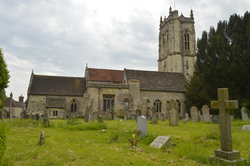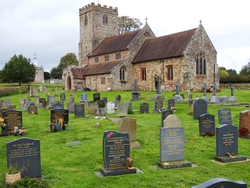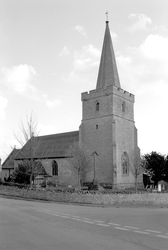
The Corpus of ROMANESQUE SCULPTURE in Britain & Ireland

St Gregory (now)
Parish church
Pentlow is a small village in the Braintree district of north Essex, on the S side of the River Stour that forms the Suffolk border. The closest major town is Sudbury, 4 miles to the SE. The modern village centre is a mile to the S of the hall and the church, which form a group close to the river and effectively hidden from the road.
The church is of flint and pebble rubble with ashlar dressings. It consists of a 12thc nave with a 19thc S porch of brick and knapped flint; an apsidal chancel, and a round W tower and a N chancel chapel that were added in the 14thc. The chapel was remodelled c.1600 when it became the Kempe chapel, housing three imposing effigies. Pentlow is one of only six round-towered churches in Essex. Romanesque features are the font, the nave W doorway, now inside the later tower and decorated with an animal head at the apex, and a base re-used as building material at the SW angle of the nave.
Parish church
Of Saxon origin and built of a Cotswold-type stone. Tower, aisled nave and chancel, the last rebuilt in the early 14thc. The nave upper walls have remnants of pre-Conquest windows and doors, completely blocked. The piers and responds of the nave arcades are basically 12thc.; the arches are pointed except for those at the W end, which are round-headed and terminate in a later W wall. Romanesque sculpture is also found in the doorway once in the N wall but now reset in the S.
Parish church
The village is located in the Blackmore Vale in north Dorset and sits above the river Stour. The present building consists of a chancel rebuilt c.1882, a 14thc N chapel; a 15thc S chapel; a nave with a late-14thc N aisle; a S aisle and a porch of c.1852, and a 15thc W tower.
The only Romanesque architectural sculpture is a pier, with capitals, that forms part of the N arcade. A 12thc font bowl also survives, now located in the S aisle.
Parish church
The village of Morville is three miles west of Bridgnorth. The building dates essentially from the 12thc, but there are two separate building phases. The nave dates from the early part of the 12thc and the aisle from the end of the century. Round-headed windows are in the S aisle wall and at the W end of the S aisle. A round-headed window on the upper storey of the W wall of the nave indicates that the tower was added later, but probably not much later as the tower is of a 12thc date as well. The top storey of the tower is later, probably late medieval.
The S doorway, which is decorated with some sculpture, is of a 12thc date; the porch is later. The doorway has been subject to extensive restoration. This is true especially of the capitals. There is a blocked-up doorway with a pointed arch on the outside of the N aisle. A Gothic window, probably from the 14thc, is to the L of this doorway. The chancel is 12thc, but with later medieval and 19thc additions. There is a round-headed priest's doorway on the S side of chancel. The priest's doorway was remodeled in the 17thc, but retains some 12thc sculpture.
The rounded-headed chancel arch from the first half of the 12thc is decorated with sculpture. The nave arcades of three bays are round-headed. Sculptural decoration occurs on the capitals of the nave arcades and at the meeting points of the arch labels. The clerestory is 19thc.
A richly carved 12thc font is situated at the W end of the nave.
Parish church
Welford is a village on the river Lambourn in west Berkshire, 5 miles NW of Newbury. To the W of the village is Welford Park, formerly a grange of Abingdon abbey, and the church stands on the eastern edge of the park. The church by T Talbot Bury dates from 1852-55, and consists of a chancel, an aisled nave with a south porch and a round west tower. None of these features are medieval although the round tower copies the original 12thc one. Only the font is Romanesque.
Parish church
A small church sited on a hill above the village. It has an aisleless Romanesque nave with recut windows. Romanesque sculpture is found on the N doorway, on the chancel arch and on some chancel windows. Grey stone with some red; of rubble except for the grey ashlar late medieval tower.
Parish church
Built of rubble masonry, the church has a 12thc. nave and chancel, and a later medieval S transept, W tower and timber N porch. Romanesque sculpture is found in the S and N doorways; at least the S doorway was reset in 1880.
Chapel, formerly parish church
The church was rebuilt in 1858 (tower in 1872); however, it preserves a Romanesque tympanum over the S door and a font. Both features have been dated to the first half of the 12thc.







